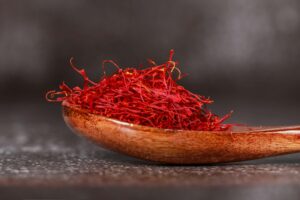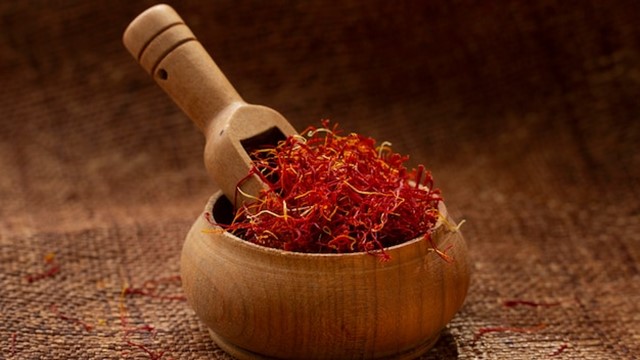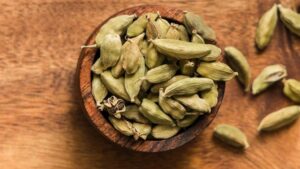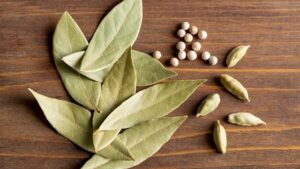Saffron is a highly prized spice derived from the dried stigmas of the Crocus sativus flower. It is revered for its vibrant color, distinct flavor, and various applications in culinary, medicinal, and cosmetic practices.

Key Characteristics of Saffron:
The key characteristics of saffron, the prized spice derived from the Crocus sativus flower, include:
Vibrant Color:
Saffron possesses a vibrant and intense reddish-golden color, attributed to the presence of natural pigments, primarily crocin and crocetin, found in the stigmas of the flower.
Distinctive Aroma: It boasts a strong, aromatic fragrance with floral, honey-like, and slightly earthy notes, contributing to its appeal in culinary and aromatic applications.
Thread-Like Structure:
Saffron consists of fine, delicate threads or stigmas that are hand-harvested from the flower. These threads are slender and have a distinct shape, which makes them easily recognizable.Potent Flavor:
Saffron possesses a unique and intense flavor profile characterized by a slightly bitter taste with floral and honey-like undertones. Its potency requires only a small amount to impart its distinctive taste and color to dishes.
Water Solubility:
Saffron’s active components are water-soluble, allowing its vibrant color and flavor to be extracted when steeped or soaked in liquid, such as water, milk, or broth, before being added to recipes.
High Value and Rarity:
Saffron is renowned as one of the most expensive spices globally due to its labor-intensive cultivation, requiring a large number of flowers to yield a relatively small quantity of saffron threads.Natural Coloring Agent:
Its vibrant hue makes saffron a sought-after natural coloring agent in cuisines worldwide, adding a distinctive golden-yellow color to various dishes.Cultural and Culinary Significance:
Saffron holds cultural significance in many regions and is integral to traditional cuisines and culinary practices globally, featuring prominently in dishes across diverse cultures.
These characteristics collectively contribute to saffron’s uniqueness, desirability, and versatile use in culinary, medicinal, and cultural applications, making it a prized and revered spice across different cultures and cuisines.
Culinary Uses of Saffron:
Saffron, with its vibrant color, unique flavor, and aromatic properties, is a highly prized and versatile spice used in various culinary applications. Here are some common culinary uses of saffron:
- Rice Dishes:
- Paella: Saffron is a key ingredient in this iconic Spanish dish, adding both color and flavor to the rice.
- Biryani: Widely used in Indian and Middle Eastern cuisine, saffron enhances the aroma and lends a beautiful golden hue to the rice in this fragrant dish.
- Broths, Soups, and Stews:
- Saffron can be infused in warm liquids like broth or water before adding them to soups or stews, enhancing the overall flavor and color of the dish.
- Sauces and Marinades:
- Cream Sauces: It’s used in creamy sauces for pasta or seafood dishes, lending a subtle yet distinctive flavor.
- Marinades: Adding saffron to marinades for meats or seafood infuses them with a delightful aroma and a hint of flavor.
- Desserts and Sweets:
- Saffron-infused Desserts: Saffron is used in various desserts, such as saffron-flavored ice creams, custards, puddings, and cakes, providing an aromatic touch and a rich color.
- Confections: It’s used in making sweets like saffron-infused candies or as a topping for baklava or other nut-based pastries.
- Teas and Beverages:
- Herbal Teas: Saffron is steeped in hot water to create saffron-infused herbal teas, known for their aromatic and soothing qualities.
- Cocktails: Occasionally, saffron is used in the preparation of cocktails and mixed drinks, adding an exotic touch.
- Baking:
- Breads and Pastries: Some bread recipes and pastries, especially in certain cuisines, incorporate saffron to infuse them with its unique aroma and color.
- Biscuits and Cookies: It’s occasionally used in certain biscuit or cookie recipes for added fragrance and flavor.
- Spice Blends and Condiments:
- Saffron is included in spice blends such as garam masala, ras el hanout, or bouillabaisse seasoning, contributing to their complex flavor profiles.
- Flavored Butters or Oils: Infusing butter or oil with saffron creates a fragrant base for cooking or garnishing dishes.
When using saffron in cooking, a small amount is typically sufficient due to its potent flavor and color. It’s often recommended to steep saffron threads in warm liquid (such as water, broth, or milk) for a few minutes before adding them to dishes to fully extract their essence. This process enhances the dispersion of both color and flavor throughout the dish.
Medicinal and Health Benefits:
Saffron possesses potential medicinal properties and has been historically used in traditional medicine for various purposes. Some of the reported medicinal and health benefits of saffron include:
- Antioxidant Properties: Saffron contains compounds like crocin, crocetin, and safranal, which act as antioxidants. These antioxidants help protect cells from oxidative stress and damage caused by free radicals.
- Mood Enhancement: Studies suggest that saffron may have antidepressant properties and could potentially help alleviate symptoms of mild to moderate depression. It’s believed to influence neurotransmitter levels, promoting a positive mood.
- Aids in Sleep and Relaxation: Saffron has been used traditionally to improve sleep quality and induce relaxation due to its calming effects. It may help reduce insomnia symptoms and promote restful sleep.
- Potential Anti-Inflammatory Effects: Some research indicates that saffron may have anti-inflammatory properties, which could be beneficial in reducing inflammation in the body, although more studies are needed.
- Menstrual Comfort: Saffron has been used traditionally to alleviate symptoms of premenstrual syndrome (PMS) and menstrual discomfort. It may help reduce symptoms like mood swings and cramping.
- Supports Cognitive Function: Certain studies suggest that saffron may have a positive impact on cognitive function. It could potentially help improve memory and protect against age-related cognitive decline, though more research is required.
- Eye Health: Some preliminary studies suggest that saffron may contribute to eye health by protecting against age-related macular degeneration and supporting retinal health due to its antioxidant properties.
- Potential Anti-Cancer Properties: There is ongoing research on the potential anticancer effects of saffron compounds, although further studies are needed to confirm its efficacy in cancer prevention or treatment.
It’s essential to note that while saffron shows promise in various health aspects, its medicinal use should be approached with caution. Always consult with a healthcare professional before using saffron or any other natural remedy for medicinal purposes, especially if you have existing health conditions or are taking medications. Incorporating saffron into a balanced diet in culinary amounts may offer subtle health benefits, but using it for therapeutic purposes requires proper guidance and supervision from a qualified healthcare provider.
Cultural Significance:
Saffron holds significant cultural and symbolic importance across various regions and cultures worldwide. Some key aspects of saffron’s cultural significance include:
- Symbol of Wealth and Luxury: Historically, saffron has been associated with luxury, prosperity, and wealth due to its rarity and high value. It was used as a status symbol by royalty and the elite in ancient times.
- Culinary Tradition: Saffron has deep roots in traditional cuisines across cultures. It’s an essential ingredient in many dishes, especially in Middle Eastern, Indian, Mediterranean, and Spanish cuisines. Its use in cultural recipes and rituals has been passed down through generations.
- Cultural Festivals and Ceremonies: Saffron plays a role in various cultural ceremonies, festivals, and rituals. It’s used in religious ceremonies, weddings, and cultural celebrations, symbolizing purity, auspiciousness, or as an offering.
- Traditional Medicine and Herbal Practices: Saffron has been utilized in traditional medicine systems, including Ayurveda, traditional Chinese medicine, and Persian medicine, for its potential health benefits. It’s used to address various ailments and promote overall well-being.
- Art and Literature: Saffron’s vibrant color and unique properties have inspired artists, writers, and poets throughout history. It’s referenced in literature, poetry, paintings, and cultural artworks, symbolizing beauty, richness, or emotional depth.
- Cultural Identity: In certain cultures and regions, saffron cultivation and trade contribute significantly to the local economy and are part of the cultural identity. Regions known for saffron production often take pride in their heritage associated with this valuable spice.
- Religious Symbolism: In some religious traditions, saffron is considered sacred and holds symbolic significance in religious rituals or ceremonies. It’s used as an offering or incorporated into religious practices.
- Traditional Clothing and Textiles: Saffron’s distinctive color has been used in traditional clothing and textiles in some cultures, symbolizing tradition, spirituality, or cultural identity.
Saffron’s cultural significance transcends its culinary uses, extending to various aspects of cultural heritage, symbolism, art, and spirituality in societies around the world. Its rich history and deep-rooted associations have contributed to its enduring value and importance in diverse cultural practices and traditions.
Dishes made by saffron
Saffron, with its unique flavor and vibrant color, is used to enhance a wide array of dishes across various cuisines. Here are some dishes that prominently feature saffron:
- Paella: A traditional Spanish dish known for its vibrant color and rich flavors, paella typically includes saffron-infused rice, mixed with seafood (such as shrimp, clams, or mussels), chicken, vegetables, and spices.
- Risotto Milanese: An Italian rice dish originating from Milan, risotto Milanese is prepared with Arborio rice, flavored with saffron, onions, white wine, and Parmesan cheese, resulting in a creamy and aromatic dish.
- Biryani: A fragrant rice dish popular in South Asian cuisine, biryani incorporates saffron-infused rice layered with marinated meat (such as chicken, lamb, or goat), aromatic spices, and sometimes vegetables.
- Zereshk Polo: An Iranian dish featuring saffron-infused rice mixed with barberries (zereshk), garnished with saffron-soaked almonds or pistachios, and often served alongside chicken or lamb.
- Saffron-infused Soups: Soups such as bouillabaisse, a traditional French seafood stew, or Italian saffron-infused broths often utilize saffron to impart both color and flavor to the dish.
- Saffron-infused Desserts: Saffron is used in various desserts and sweets, including saffron-flavored ice creams, custards, rice puddings, and cakes, adding a distinctive aroma and golden color.
- Kesar Peda: A popular Indian sweet made from condensed milk, sugar, and saffron, flavored with cardamom and garnished with nuts. It has a rich, creamy texture and a delightful saffron taste.
- Saffron Tea or Kahwa: A traditional tea in Middle Eastern and South Asian cultures, kahwa is infused with saffron, cardamom, cinnamon, and sometimes nuts like almonds, offering a fragrant and aromatic beverage.
- Saffron-infused Pastries: Saffron is used in the preparation of certain pastries and baked goods, such as saffron-infused biscuits, cookies, or bread, providing a unique flavor and color.
- Saffron-infused Cream Sauces: It’s employed in cream-based sauces, adding a delicate yet distinct flavor to dishes like saffron-infused creamy pasta sauces or sauces for seafood.
Saffron’s subtle yet distinctive flavor and vibrant color make it a sought-after ingredient in various cuisines, enhancing both savory and sweet dishes, adding depth and complexity to their taste profiles.




